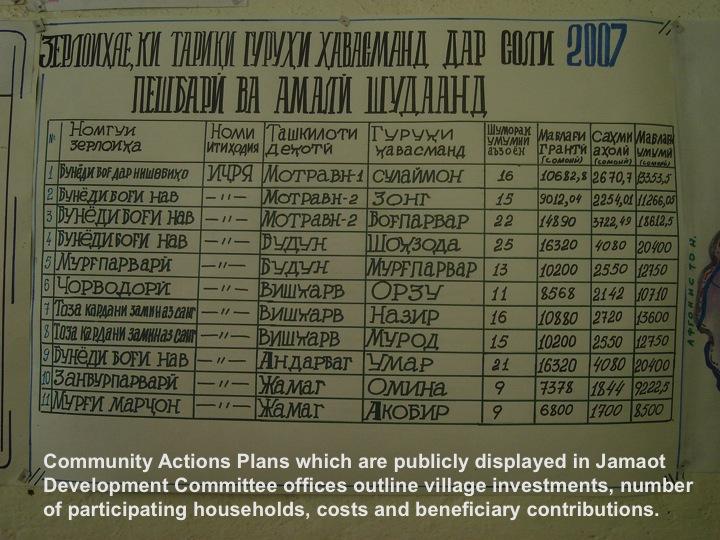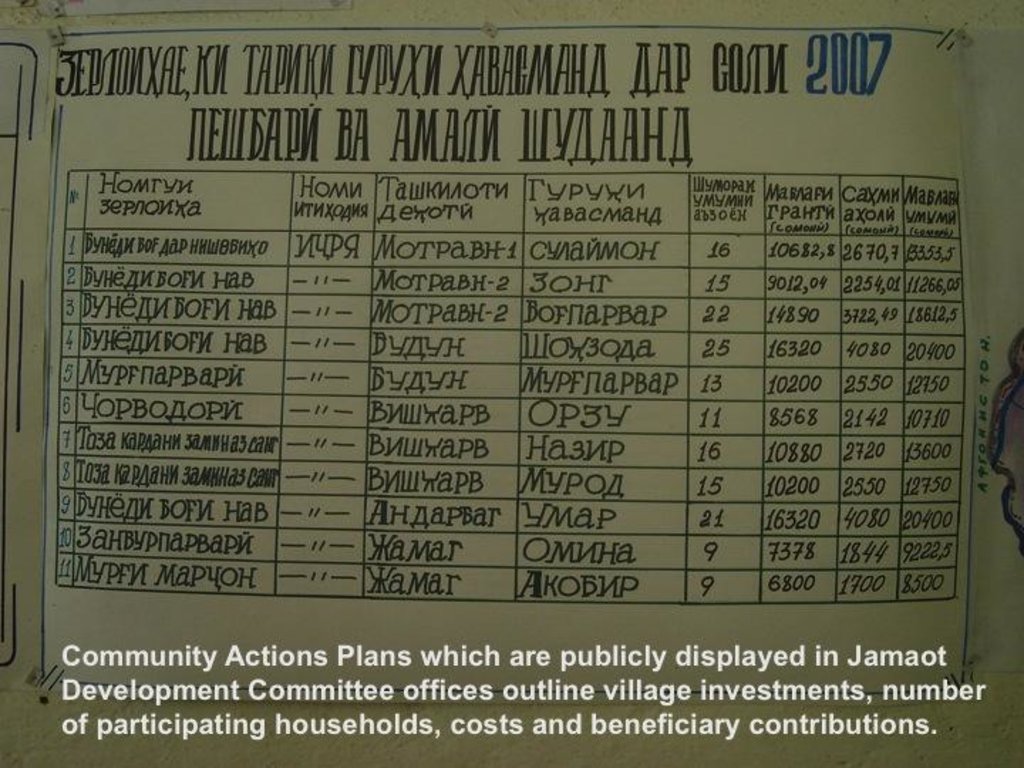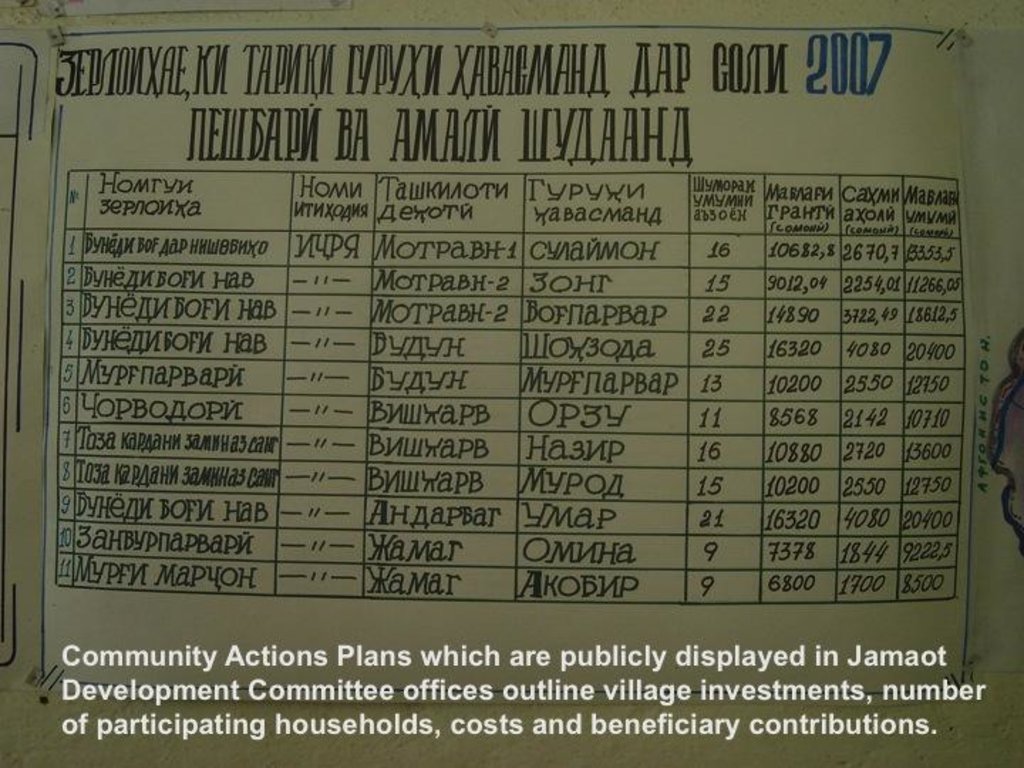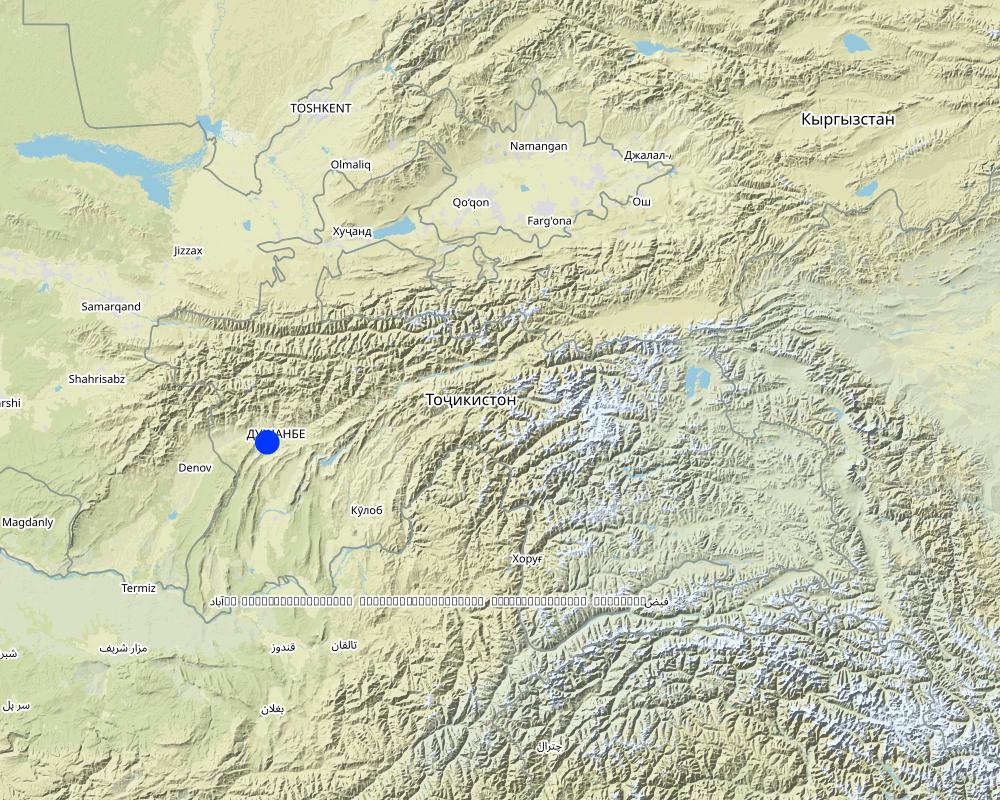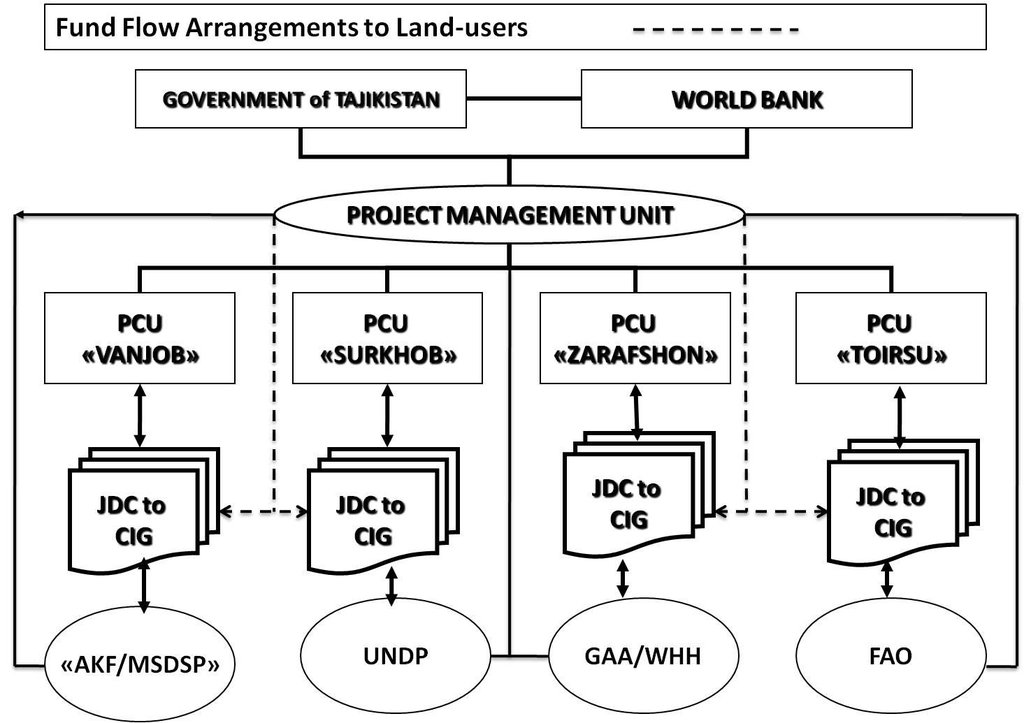SLM small grant allocation mechanisms [Tajikistan]
- Creation:
- Update:
- Compiler: Nandita Jain
- Editor: –
- Reviewers: David Streiff, Alexandra Gavilano, Joana Eichenberger
approaches_2453 - Tajikistan
View sections
Expand all Collapse all1. General information
1.2 Contact details of resource persons and institutions involved in the assessment and documentation of the Approach
SLM specialist:
Mott Jessica
World Bank
Name of project which facilitated the documentation/ evaluation of the Approach (if relevant)
Pilot Program for Climate Resilience, Tajikistan (WB / PPCR)Name of the institution(s) which facilitated the documentation/ evaluation of the Approach (if relevant)
World Bank (World Bank) - United States1.3 Conditions regarding the use of data documented through WOCAT
The compiler and key resource person(s) accept the conditions regarding the use of data documented through WOCAT:
Yes
2. Description of the SLM Approach
2.1 Short description of the Approach
Mechanisms to facilitate participatory decision-making about grant allocation among land users and improve transparency and accountability in flow of funds to beneficiaries in small-grant programmes for SLM.
2.2 Detailed description of the Approach
Detailed description of the Approach:
Aims / objectives: As part of the Community Agriculture & Watershed Management Project (CAWMP), this approach helped beneficiaries and project partners allocate grants and manage the flow of funding while promoting fairness, transparency, and ownership. It facilitated appropriate SLM choices across the highly variable agricultural, climatic and geographic conditions. Almost 4000 rural investments including SLM technologies were implemented, resulting in over 96,000ha under improved land management practices and benefits for more than 43,000 households in Tajikistan’s uplands.
Methods: This approach set a fixed budget per village, limited the grant value received per household as well as the total size of any one grant, required minimum levels of beneficiary contributions, and provided grant money to beneficiaries, enabling them to purchase the inputs.
Stages of implementation: Fixed village budget: In their Community Action Plans (CAP) villages assigned priorities to grants within a set budget amount for the entire village. Project guidelines specified a formula for this budget based on amounts per investment type per household excluding beneficiary contributions ($30/household for farm productivity, $74/household for land management, and $30/household for rural infrastructure). The number of households in a village multiplied by these per-household-amounts determined the overall size of the grant funding for that village. Grant allocation limits. The villages were informed of their overall budget as well as the household limits for each category. They chose investments for groups of households (Common Interest Groups, CIGs) and allocated grant funds to subprojects accordingly. The household limits ensured that collectively at least 50% of the families would benefit directly. In practice, about 75%, of a total of about 57000 households in the project sites participated in the farm productivity and land resource management investments, and 60% in rural infrastructure investments. Grant size. Except in a few cases requiring special approval, the Project-financed grants for each subproject were lower than US$5,000, which reduced risks of the funds being used for purposes for unrelated to the Project. Beneficiary Contribution. Beneficiaries were required to contribute a minimum of 25% of the grant amount in labor, materials or cash which increased their stake in the investment, thereby strengthening ownership and sustainability. At least 5% of the grant amount for rural infrastructure had to be contributed in cash at the start in order to demonstrate financial sustainability.
Role of stakeholders: Fund flow. Once a grant proposal was approved, the PMU transferred the grant amount to the local savings bank according to the schedule specified in the agreement between Jamoat Development Committee (JDC) and CIGs. The JDC accountant transferred the funds fromthe bank to the CIGs. The CIGs then had the responsibility for purchasing inputs, which created an incentive for selecting cost-effective inputs.
2.3 Photos of the Approach
2.5 Country/ region/ locations where the Approach has been applied
Country:
Tajikistan
Region/ State/ Province:
Sughd, Region of Republican Subordination, Khatlon, GBAO
Further specification of location:
Jirgital, Tajikibad, Vanj, Aini, Matcha, Penjikent, Danghara
Comments:
The Community Agriculture and Watershed Management Project was implemented in four project sites/watersheds - Surkhob, Toirsu, Vanjob and Zarafshan - which included 7 districts/raions and 39 sub-districts/jamoats. The total catchment area was 35,000km2. Total arable, farm and pasture land was approximately 319,500ha.
Map
×2.6 Dates of initiation and termination of the Approach
Indicate year of initiation:
2005
Year of termination (if Approach is no longer applied):
2012
2.7 Type of Approach
- project/ programme based
2.8 Main aims/ objectives of the Approach
The Approach focused mainly on other activities than SLM (small grant programmes, participatory decision-making, village-level, fixed budgets, fund flow arrangements, farmer groups)
Practical and feasible mechanisms for beneficiaries and project partners for: a) grant allocation and fund flow that promote fairness, transparency, and beneficiary ownership in the context of Tajikistan; and b) facilitate appropriate SLM choices across the highly variable agro-climatic and other geographic conditions of the country.
The SLM Approach addressed the following problems: Prior to CAWMP, no practical incentives in donor-funded grant programmes for beneficiaries to consider how to optimise returns according to local conditions. Limited choice of technologies, elite capture of resources, requests for large grants and absence of beneficiary contributions led to inappropriate investments for local agro-climatic conditions, and poor returns and investments not maintained in subsequent years.
2.9 Conditions enabling or hindering implementation of the Technology/ Technologies applied under the Approach
social/ cultural/ religious norms and values
- hindering
Grant allocations vulnerable to elite capture and/or political influence. Time taken to address such pressures.
Treatment through the SLM Approach: Participatory planning and full disclosure at the start of planning to villagers of available funding and its calculation at village and household levels.
availability/ access to financial resources and services
- hindering
Beneficiary dependence on donors/implementing agencies since resources given were “in-kind” and not cash.
Treatment through the SLM Approach: Adopted “good practice” from other countries with arrangements for direct cash transfers to beneficiaries organised as groups of farmers who then had responsibility for managing financial resources and procurement for chosen investments.
institutional setting
- hindering
Lack of active participation by beneficiaries in decision-making over grant amounts and choice of investments.
Treatment through the SLM Approach: Innovative rules about grant allocations enabling villagers to consider various options of grant amounts and types of investments in a participatory manner, taking into account their local conditions.
knowledge about SLM, access to technical support
- hindering
Participatory planning processes lacked consideration of multiple factors, e.g., grant amount, choice of technologies, local context, beneficiary contribution, selection of beneficiaries.
Treatment through the SLM Approach: Inclusion of participatory rural appraisal, formulae and rules governing grant allocations in CAP preparation. First 3 proposals for each investment category in project sites reviewed to assess understanding of guidelines. Random review thereafter.
3. Participation and roles of stakeholders involved
3.1 Stakeholders involved in the Approach and their roles
- local land users/ local communities
CIGs (Groups of households)
Local cultural and social conditions determined the extent to which women took part in the grant allocation decision-making, and as members of CIGs managing small grant funds. In some more remote communities, it was not generally acceptable for women to be active participants. In other areas, women only CIGs were formed.
Marginal groups within a generally poor upland rural population participated in grant allocation decisions and as CIG members in managing small grant funds. In some villages, vulnerable and poor households were targeted as priority recipients of grants through the allocation mechanism.
Participated grant allocation decision making and fund management
- NGO
JDCs – locally registered NGOs
JDCs managed fund transfers to CIGs based based on formal agreements
- national government (planners, decision-makers)
Project Management Unit
If several stakeholders were involved, indicate lead agency:
Project Management Unit and CIGs
3.2 Involvement of local land users/ local communities in the different phases of the Approach
| Involvement of local land users/ local communities | Specify who was involved and describe activities | |
|---|---|---|
| initiation/ motivation | none | |
| planning | passive | Potential beneficiaries consulted for social assessment conducted during project design which then influenced project approaches. |
| implementation | interactive | Villagers made grant allocation decisions. CIGs managed grant funds and bought inputs. |
| monitoring/ evaluation | interactive | JDCs release grant funds according to benchmarks in formal agreements with CIGs. |
| Research | none |
3.3 Flow chart (if available)
Description:
CAWMP - Implementation Arrangements and Fund Flow Arrangements to Land-Users
Author:
Project Management Unit (Dushanbe, Tajikistan)
3.4 Decision-making on the selection of SLM Technology/ Technologies
Specify who decided on the selection of the Technology/ Technologies to be implemented:
- mainly land users, supported by SLM specialists
Explain:
Villagers made decisions on grant amounts, types of investments and beneficiaries. SLM specialists from project partners such as FOS and PCUs assisted in choice of SLM technologies to be used for investments.
Decisions on the method of implementing the SLM Technology were made by mainly by land users supported by SLM specialists. See 2.1.5.1. above - How were decisions on the choice of SLM technologies made. Villagers made decisions on grant amounts, types of investments and beneficiaries. SLM specialists from project partners such as FOS and PCUs assisted in choice of methods for SLM technologies to be used for investments.
4. Technical support, capacity building, and knowledge management
4.1 Capacity building/ training
Was training provided to land users/ other stakeholders?
Yes
Specify who was trained:
- land users
- field staff/ advisers
- JDCs
Form of training:
- public meetings
Subjects covered:
Grant allocation mechanisms. Fund flow arrangements and management.
4.2 Advisory service
Do land users have access to an advisory service?
No
4.3 Institution strengthening (organizational development)
Have institutions been established or strengthened through the Approach?
- yes, moderately
Specify the level(s) at which institutions have been strengthened or established:
- local
Give further details:
JDCs received financial support for certain staff, some equipment for their offices, and training (see also TAJ047 for more information on JDC roles in the project). Note-cannot select more than one type of support in the pull-down menu
4.4 Monitoring and evaluation
Is monitoring and evaluation part of the Approach?
Yes
Comments:
no. of land users involved aspects were regular monitored by project staff through measurements; indicators: Grant allocation – number of beneficiaries
Grant allocation aspects were regular monitored by project staff through observations; indicators: Grant allocation - Estimated costs of rural investments
Fund flow aspects were regular monitored by project staff through measurements; indicators: Fund flow - Timeliness of transfers from PMU to JDCs to CIGs,
There were few changes in the Approach as a result of monitoring and evaluation: Delays in initial fund flow to CIGs due to a lack of details in financial management arrangements. Elaboration of manuals and training addressed this problem.
There were no changes in the Technology as a result of monitoring and evaluation: Not directly relevant
5. Financing and external material support
5.2 Financial/ material support provided to land users
Did land users receive financial/ material support for implementing the Technology/ Technologies?
No
5.4 Credit
Was credit provided under the Approach for SLM activities?
No
6. Impact analysis and concluding statements
6.1 Impacts of the Approach
Did the Approach help land users to implement and maintain SLM Technologies?
- No
- Yes, little
- Yes, moderately
- Yes, greatly
The grant allocation mechanism fostered multi-factor decision-making, including consideration of local environmental conditions, by villagers. Fund flow arrangements enabled JDCs to manage about $7.4 million in small grants to about 4000 CIGs for rural production investments.
Did the Approach empower socially and economically disadvantaged groups?
- No
- Yes, little
- Yes, moderately
- Yes, greatly
The project population is considered generally poor or very poor. Within this population, particularly vulnerable groups participated in rural production investments.
Did other land users / projects adopt the Approach?
- No
- Yes, little
- Yes, moderately
- Yes, greatly
: Portions of the approach and associated guidelines have been adopted in other donor-funded projects.
Did the Approach lead to improved livelihoods / human well-being?
- No
- Yes, little
- Yes, moderately
- Yes, greatly
Mechanisms contributed to increased livelihood assets for more than 43,000 households through the implementation of about 4000 small grants.
Did the Approach help to alleviate poverty?
- No
- Yes, little
- Yes, moderately
- Yes, greatly
Target population generally considered poor or very poor. Assessment of impacts on poverty are included in the project evaluation being conducted in 2011.
6.2 Main motivation of land users to implement SLM
- increased production
- well-being and livelihoods improvement
6.3 Sustainability of Approach activities
Can the land users sustain what has been implemented through the Approach (without external support)?
- yes
If yes, describe how:
Grant allocation mechanism was understood and could be used for other sources of financing for groups of households at the village level. Fund flow mechanisms will require a sub-district presence to support transfers to village-based groups.:
6.4 Strengths/ advantages of the Approach
| Strengths/ advantages/ opportunities in the land user’s view |
|---|
| To be added based on project evaluation in 2011 |
| Strengths/ advantages/ opportunities in the compiler’s or other key resource person’s view |
|---|
| Grant allocation mechanism easily understood and perceived to be fair and transparent. (How to sustain/ enhance this strength: Document application and disseminate widely.) |
| Multiple factors considered in decision-making including grant amount, choice of investment and number of beneficiaries, local conditions. (How to sustain/ enhance this strength: Improved environmental analyses in participatory planning would lead to more suitable choice of investments.) |
| CIG management of funds contributed to improved accountability and incentives to sustain investments. (How to sustain/ enhance this strength: Document and disseminate methods and results.) |
7. References and links
7.2 References to available publications
Title, author, year, ISBN:
perational Manual for Community Mobilization, Rural Production Investments and Research and Demonstration Grants (2008)
Available from where? Costs?
Project Management Unit
Title, author, year, ISBN:
Operational Manuals for JDCs and CIGs in Financial Management and Procurement (2007)
Available from where? Costs?
Project Management Unit
Title, author, year, ISBN:
CAWMP: Project Appraisal Document (2005)
Available from where? Costs?
World Bank website
Links and modules
Expand all Collapse allLinks
No links
Modules
No modules


